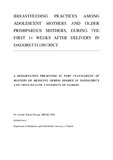| dc.contributor.author | Mwangi, Caroline W | |
| dc.date.accessioned | 2014-12-08T13:23:57Z | |
| dc.date.available | 2014-12-08T13:23:57Z | |
| dc.date.issued | 2014 | |
| dc.identifier.uri | http://hdl.handle.net/11295/76590 | |
| dc.description.abstract | Background:
Adolescents make up 18% of the world’s population. An estimated 16 million (11%) of all live births
worldwide are to girls aged 15 to 19 years. Exclusive breastfeeding for the first 6 months of life has
been demonstrated to offer adequate nutrition and prevent common gastrointestinal and upper
respiratory tract infections and consequently reduction in childhood mortality. Adolescent mothers
face unique challenges and influences when making a choice on how to feed their infants.
Adolescent mothers have been shown to deviate from the recommended infant and young child
feeding practices thus leading to a large number of infant deaths of children born to them.
Objectives
Comparison of breastfeeding practices between adolescent mothers (aged 14 to 19 years) and older
primiparous mothers (aged 20 years and older) in the first 14 weeks after delivery namely initiation
of breastfeeding and rates of exclusive breastfeeding at 6, 10 and 14 weeks. Secondary objectives
were nutritional assessment at 6, 10 & 14 weeks in both groups and a mortality audit.
Methods
This was longitudinal survey carried out in 3 government health facilities in Dagoretti district,
Nairobi County namely Mbagathi District Hospital, Riruta Health Centre and Ngong Road Health
Centre. The study participants were recruited from these facilities and followed up for 14 weeks.
Weight and length were measured at 6, 10 and 14 weeks in addition to assessment of breastfeeding
practices at these time intervals using a questionnaire.
Results
We enrolled 102 adolescent mothers and 102 mothers aged 20 years and above. The mean age of the
adolescent mothers was 18.4 years and the mean age for the older mothers was 23.6 years. The study
found that 50% of adolescent mothers initiated breastfeeding within 1 hour compared to 48% of the
older mothers. There was no significant difference (p value 0.78). The study did not find a significant
difference in rates of exclusive breastfeeding between the adolescent mothers and the older mothers
at 6, 10 and 14 weeks. The p values for rates of exclusive breastfeeding between the two groups
were 0.67, 0.58 and 0.39 at 6, 10 and 14 weeks respectively. A comparison of nutritional assessment
at 6, 10 and 14 weeks between the adolescent mothers and those aged 20 years and older did not
show a significant difference. We found significantly more deaths among infants born to adolescent
mothers compared to older mothers at 10 weeks (p value 0.03). There were 5 infants who died
among those born to adolescent mothers at 10 weeks compared to no deaths among infants born to
older mothers at 10 weeks.
Conclusion
There are no significant differences between the breastfeeding practices of adolescent mothers and
mothers aged 20 years and older. However there are more deaths among infants born to adolescent
mothers at 10 weeks of life compared to older mothers.
Recommendations
Further studies need to be done on mortality of infants born to adolescent mothers and any
associations that may increase the rate of mortality. Counselling of mothers at both the antenatal,
postnatal and well baby clinics should be intensified on recommended breastfeeding practices. | en_US |
| dc.language.iso | en | en_US |
| dc.publisher | University of Nairobi | en_US |
| dc.title | Breastfeeding practices among adolescent mothers and older primiparous mothers, during the first 14 weeks after delivery in Dagoretti district | en_US |
| dc.type | Thesis | en_US |
| dc.description.department | a
Department of Psychiatry, University of Nairobi, ; bDepartment of Mental Health, School of Medicine,
Moi University, Eldoret, Kenya | |
| dc.type.material | en_US | en_US |

